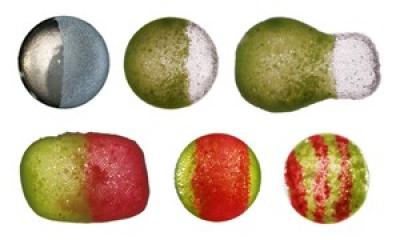More concept than reality, nonetheless, the possibilities offered by this Scandinavian research are appealing. From a Dec. 16, 2014 news item on ScienceDaily,
Embryonic faults in subsea high voltage installations are difficult to detect and very expensive to repair. Researchers believe that self-repairing materials could be the answer.
The vital insulating material which encloses sensitive high voltage equipment may now be getting some ‘first aid’.
“We have preliminary results indicating that this is a promising concept, but we need to do more research to check out other solutions and try the technique out under different conditions.” So says SINTEF [largest independent research organisation in Scandinavial researcher Cédric Lesaint, who is hoping that the industry will soon wake up to the idea.
A Nov. 26, 2014 SINTEF press release, which originated the news item, describes the concept in more detail,
The technology used involves so-called ‘microcapsules’, which are added to traditional insulation materials and have the ability to ‘sniff out’ material fatigue and then release repairing molecules. The team working on this project is made up of chemists, physicists and electrical engineers. If they succeed, they may have discovered the next generation of insulating materials which can be applied in costly electrical installations.
The press release then describes a phenomenon named ‘electrical trees’,
So-called electrical trees develop in electrical insulation materials that are approaching the end of their useful lives. Electrical stress fields exploit small weaknesses in the insulation material and generate hair-thin channels that spread through the material like the branches of a tree. When the channels finally reach the surface of the insulation material, the damage is done and short-circuiting will occur.
“Short-circuiting is almost always linked to an electrical tree”, explains Lesaint’s colleague, Øystein Hestad.
Faults of this kind are extremely expensive to repair, especially if they occur in a device installed on an offshore wind farm or a subsea oil production installation – perhaps even under inhospitable Arctic conditions.
Under such conditions, say researchers, self-repairing insulation materials represent a cost-effective alternative to traditional repair methods.
The specific solution the researchers propose (from the press release),
SINTEF researchers have based their work on an established idea developed to repair mechanical damage and cracks in composite materials. The composites are mixed with microcapsules filled with a liquid monomer – single molecules which have the property to join with each other (polymerise) to form long-chain molecules. If cracks or other forms of damage encroach on the capsules, the monomer is released and fills the cracks.
“As far as we know, we’re the first to have tested this technique on damage resulting from electrical stress fields”, says Lesaint.
The microcapsules they incorporated into the insulation materials burst when they encounter one of the branches of an electrical tree. The liquid monomer then invades the thin channels forming the ‘tree’ and polymerises. The channels are filled in and the electrical degradation of the insulation material is halted.
In this way the ‘immune defences’ of the insulation material are strengthened, and the lifetime of the installation extended.
As promising as the research is, the scientists are looking for funds (from the press release),
This summer [2014], the SINTEF research team presented the concept at a conference in Philadelphia, USA.
“Many people were surprised, especially when they realised that we had chosen to share the concept with others”, says Lesaint. “Taking the chance that other researchers might steal such a good idea is a risk we have to take”, he says.
The industry has also expressed some interest, but so far not enough to consider funding further research.
“We’re being met with curious interest, but have been told to come back when we have more test results”, says Lesaint. “The problem is that at present we have insufficient funds to conduct the research needed to carry the project forward”, he says.
Next year [2015?] will thus decide as to whether this self-repairing project will take the step from being a promising concept to becoming the next generation of insulation materials.
You can also find the press release/article by Lars Martin Hjortho here in a Gemini.no newsletter.
Here’s an illustration the researchers have made available,
![Subsea installations can get longer life-time with self-repairing materials. Illustration: SINTEF Energy [downloaded from http://gemini.no/en/2014/11/self-repairing-subsea-material/]](http://www.frogheart.ca/wp-content/uploads/2014/12/SubseaInstallation-300x150.png)


![Functionalised particles to speed up oil flow While the SINTEF project focuses on plugging holes, the NTNU-led project is looking to speed up the flow of oil. Much of a reservoir’s oil remains trapped in small rock pores. NTNU researchers will be customising nanoparticles that can help to dislodge this oil and dramatically increase the amount of oil that can be recovered. One method will utilise “Janus particles”, which feature a special surface of two different hemispheres: one is hydrophilic (attracted to water), the other hydrophobic (attracted to oil). Down in the reservoir, where both oil and water are found, the nanoparticles will spin like wheels and push the oil forward. “This is an early-stage project,” says project manager Jianying He, an associate professor at the NTNU Nanomechanical Lab. “But the idea is very exciting and has major potential for raising the recovery rate of Norwegian oil.” The petroleum companies Det norske and Wintershall are signed on as partners, and project researchers will be communicating with Statoil as well. The University of Houston is the research partner. The second method involves changing the surface charge of nanoparticles to make them capable of slipping between a reservoir’s oil and rock. If development proceeds as planned, Professor He estimates that the nanoparticles will be on the market in roughly seven years. She sees two challenges to using nanoparticles for enhanced recovery: HSE and production capacity. HSE should not be problematic in this case, as studies show that silica-based particles are not hazardous to the environment. Production capacity, however, may prove to be an obstacle to large-scale utilisation of nanoparticles. Petroleum companies would need millions of tonnes of nanoparticles daily. Currently there is no facility that can produce such quantities. [downloaded from http://www.forskningsradet.no/en/Newsarticle/Nanotechnology_to_recover_stubborn_oil/1253992231414/p117731575391]](http://www.frogheart.ca/wp-content/uploads/2014/01/TrappedOilGasWater.jpeg)
